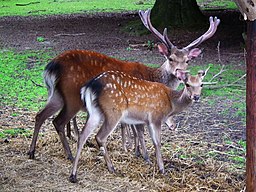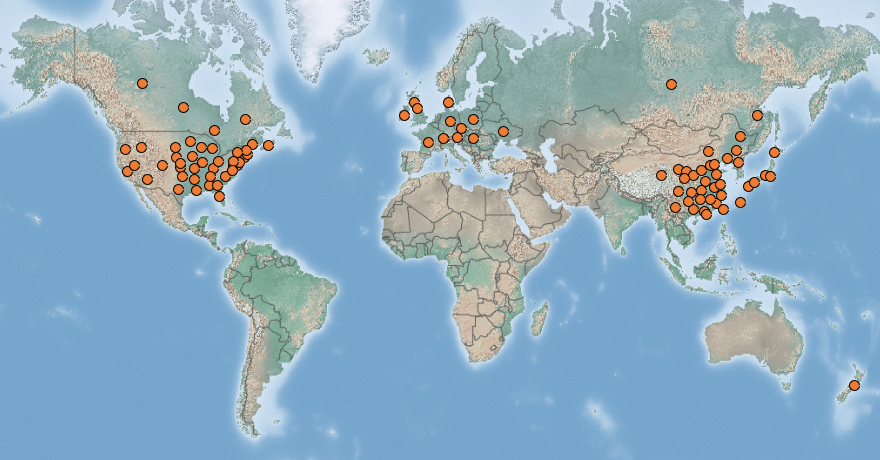 |
Sika deer | Status LU: casual. 1st record: 2012. |
 |
Sikahirsch | Status Eur.: established. |
 |
Cerf Sika | RA: ISEIA: B1, Watch List. Harmonia+: n/a. |
 |
Sikahirsch | Wikipedia: |
 |
Sikahert | Back to the list of vertebrates |
Contents
Report the species
→ Report Cervus nippon to the National Museum of Natural History.
Brief description
Cervus nippon Temminck, 1838 is found in dense woodland and scrub, including the thicket stages of coniferous forests and adjacent open ground. The population of the species is increasing and expanding in several European countries. Sika can build up higher densities than red dear and can cause great environmental and economic damage to forests and wetlands. Hybrids with the native congeneric red deer are fertile, and further hybridisation or back-crossing to either parental type is rapidly threatening the genetic integrity of the native species. Sika are often reported to be better competitors than native deer species (e.g. roe deer) (Branquart et al. 2013).
The species can easily be confused with the fallow deer Dama dama (Linnaeus, 1758), which the Sika deer resembles in its greetings and colouring. However, the antlers of the sika deer do not develop shovels as they do with the fallow deer as the animal ages (Schley & Herr 2019: 31).
Status and distribution in Luxembourg
Records of Cervus nippon Temminck, 1838 in Luxembourg. Data source: Recorder-Lux, iNaturalist & GBIF, 2024-10-22.
Supposedly the Sika deer migrated to north-eastern parts of the country after escaping from a deer park in Gemünd (Germany). In order to avoid hybridisation with red deer (Cervus elaphus), an eradication of the individuals found in Luxembourg is recommended.
An identification sheet of the species has been published by the MECDD in French and German.
Risk assessment
ISEIA protocol
B1 (3+2+3+1) = Watch List (Ries et al. 2014: 199).
Harmonia+ protocol
Overall risk score 0,27 = (Overall Invasion score 0,51 x Overall Impact score 0,56) (evaluated by Sandra Cellina, Jan Herr and Manou Pfeiffenschneider).
 Invasion
Invasion0,56

 Impact
Impact0,27

 Risk
RiskWorldwide distribution
Bibliography
- Branquart, E., A. Licoppe, G. Motte, V. Schockert & J. Stuyck, 2013. Harmonia database: Cervus nippon Temminck, 1838. Harmonia version 1.2, Belgian Forum on Invasive Species. URL: http://ias.biodiversity.be [accessed on 2019-10-24]
- CABI, 2009. Cervus nippon Temminck, 1838 [original text by Rory Putman]. In: Invasive Species Compendium. Wallingford, UK: CAB International. URL: www.cabi.org/isc [accessed 2020-02-05]
- Cellina, S. & L. Schley, 2014. Premières observations du cerf sika (Cervus nippon) au Luxembourg. Bull. Soc. Nat. luxemb. 115: 193-194. [PDF 100 KB]
- MNHNL, 2000-. Cervus nippon Temminck, 1838 in Recorder-Lux, database on the natural heritage of the Grand Duchy of Luxembourg. Musée national d’histoire naturelle, Luxembourg. URL: https://mdata.mnhn.lu [Accessed 2019-10-24]
- MNHNL, iNaturalist & GBIF, 2019. Cervus nippon Temminck, 1838 in MNHNL-mdata, online portal combining species observation from Recorder-Lux, iNaturalist and GBIF. National Museum of Natural History, Luxembourg. URL: https://mdata.mnhn.lu [Accessed 2019-10-24]
- Naturverwaltung , 2014. Bulletin technique de l’Administration de la nature et des forêts en matière de gestion de la faune sauvage et de chasse, numéro 3 (2014), 72 pp [http://www.environnement.public.lu/chasse/publications/bulletintechnique3/index.html].
- Pir, J.B. & L. Schley, 2015. Développement des connaissances sur la répartition et l’écologie des mammifères au Luxembourg entre 1990 et 2015. Bull. Soc. Nat. luxemb. 116: 437-455.
- Ries, C., M. Pfeiffenschneider, Engel, E., J.-C. Heidt & M. Lauff, 2014. Environmental impact assessment and black, watch and alert list classification after the ISEIA Protocol of vertebrates in Luxembourg. Bull. Soc. Nat. luxemb. 115: 195-201. [PDF 247 KB]
- Schley, L. & J. Herr, 2019. Säugetiere Luxemburgs. Hrsg.: natur&ëmwelt a.s.b.l., Ministère du développement durable et des infrastructures, Administration de la nature et des forêts. 219 S. ISBN 978-2-9199511-0-9 [French edition: Les mammifères du Luxembourg, ISBN 978-2-9199511-2-3]
Suggested citation of this webpage
Ries, C. & M. Pfeiffenschneider (Eds.), 2024. Cervus nippon Temminck, 1838. In: neobiota.lu - Invasive Alien Species in Luxembourg. National Museum of Natural History, Luxembourg. URL: https://neobiota.lu/cervus-nippon/ [Accessed 2024-10-22].
Page content last updated on 2024-03-11. Last proofread by Caroline Grounds on 2019-11-27.



